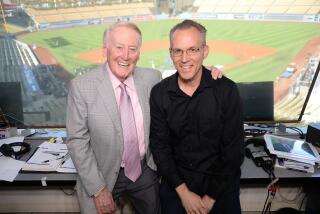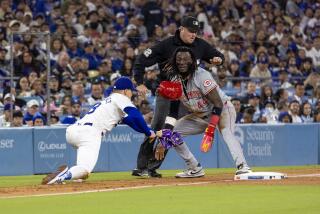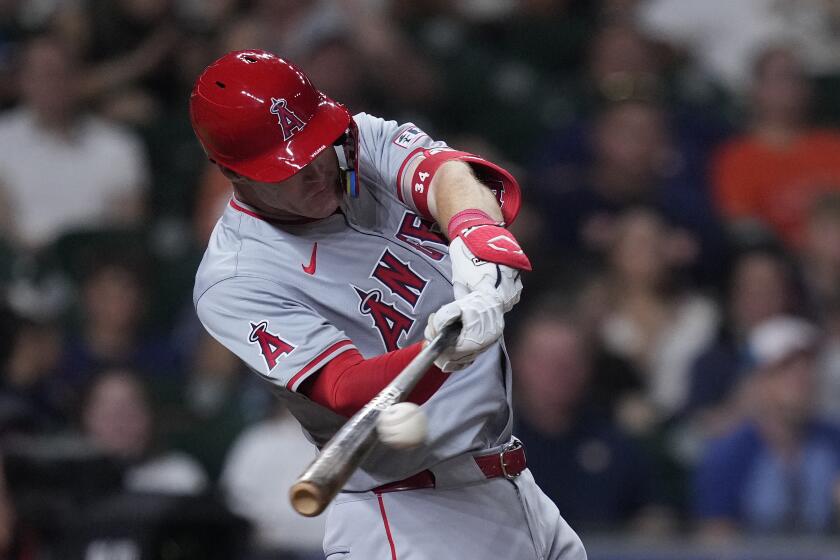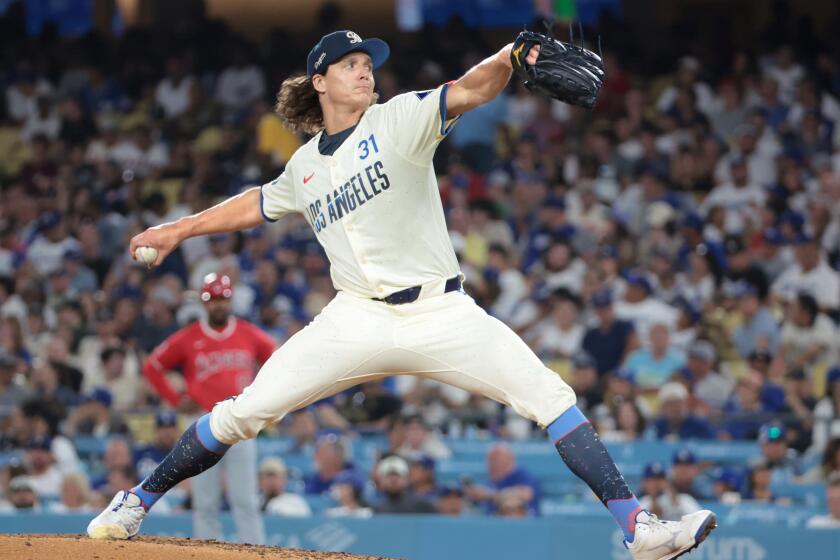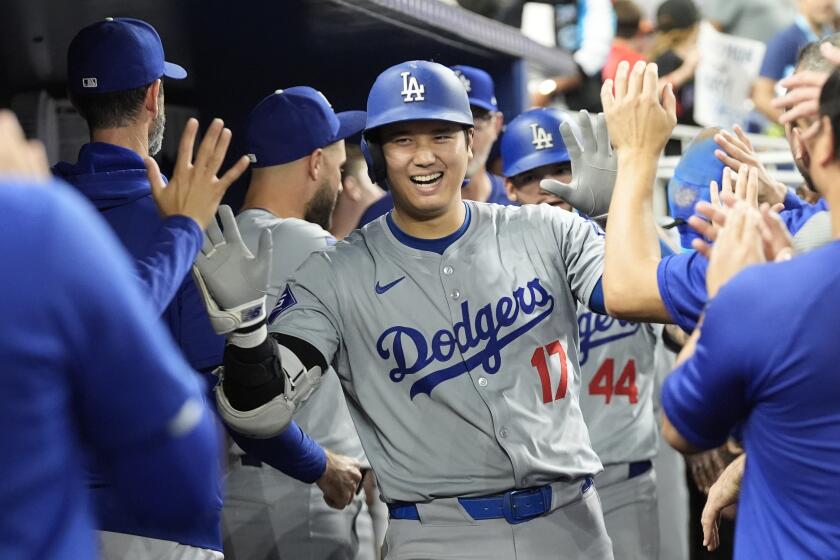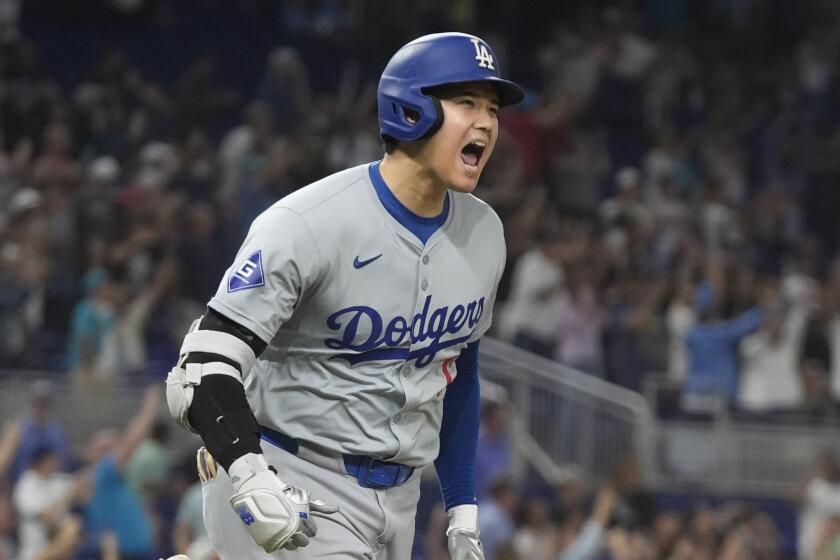The Coliseum was no ‘real baseball’
The crowds that welcomed the Dodgers to Los Angeles and continued to respond to their historic presence were enormous -- 78,652 for the first game in 1958, 93,103 for a 1959 exhibition with the New York Yankees saluting Roy Campanella, and more than 92,000 for each of three World Series games against the Chicago White Sox in 1959, when they became the first team to go from seventh place one season to a World Series title the next.
“They called the Mets in 1969 the Miracle Mets,” said Vin Scully, “but the Dodgers in 1959 were really the first miracle team.”
FOR THE RECORD:
Baseball at the Coliseum: A graphic in Saturday’s baseball special section showing the dimensions for the Dodgers-Red Sox exhibition game at the Coliseum showed the distance to the center-field fence was 300 feet. The actual distance was 360 feet. —
Almost all of baseball’s attendance records were broken in those first two seasons amid the comparatively unlimited seating and distorted field dimensions of the Coliseum, but was it real major league baseball that these long-denied fans were seeing?
That would have to wait until the 1962 opening of Dodger Stadium, at least in the view of Hall of Fame member Duke Snider, who, like other Boys of Summer, made the move from Brooklyn to Los Angeles.
It was a homecoming that the L.A.-born Snider should have been happy about -- until he saw the Death Valley distances to center field and right-center field and that awkward 42-foot-high screen stretched across left field to protect against cheap home runs from right-handed hitters.
“Baseball deserves its own identity,” Snider said from his Fallbrook home. “It shouldn’t ever be piecemealed into a football and track stadium, which is what the Coliseum is.
“Sure, it was great for drawing big crowds, but that wasn’t good baseball or real baseball people were watching, because it wasn’t a baseball field. They just slapped it in, dimension-wise. I mean, you would have thought that the powers that be would have sat down with some of the players to discuss the dimensions, but that was left up to Mr. [Walter] O’Malley and his group.”
O’Malley thought he had no alternative other than 20,000-seat Wrigley Field at 42nd Place and Avalon Boulevard, which in 1961 became the one-season home of the American League’s new Los Angeles Angels. Tonight, more than 100,000 spectators will get a reminder of the way it was 50 years ago when the Dodgers play the Boston Red Sox in an exhibition game at the Coliseum.
For Boston’s “Big Papi,” David Ortiz, and the other left-handed power hitters, they may have the same reaction Snider had when he walked on the field for that first game and encountered Willie Mays taking batting practice with the San Francisco Giants. Mays pointed to the distant fence in center and the right-field power alley, about 440 feet away, and said to Snider: “Duke, they killed you.”
Mays was right, to a point. Snider, who hit 40 or more home runs in each of his last five seasons in Brooklyn and came to Los Angeles in his prime at 31, hit 15, 23, 14 and 16 homers in 1958-61, and only 38 at the Coliseum over that span.
However, he is quick to emphasize, he has not harbored 50 years of bitterness over the dimensions. He doesn’t lose sleep thinking 407 homers might have been 500-plus.
Knee surgery in December 1957, before the first game at the Coliseum, was the key reason his production fell, he said.
“That was before arthroscopic surgery and the knee was never the same, I was never the same hitter. I had to change my whole style. I had to try to be more of a contact hitter, a tough adjustment when you’ve been a free swinger your entire career.”
The Dodgers were in transition in more ways than one when they came to Los Angeles and saw the odd-shaped field that some thought resembled New York’s Polo Grounds, which the Giants had left for San Francisco.
Campanella was in a wheelchair. Pee Wee Reese, Carl Furillo and Carl Erskine were all within a year or two of retirement. Snider was trying to be the Brooklyn Duke on one leg.
“The Boys of Summer were really past our peak,” Erskine said from his home in Ohio, “and it was tougher for us to go to L.A. and try to reprove ourselves with all those new fans thinking we would be the same players we had always been. Finishing seventh that first year was a bitter pill.”
Still, said Scully, coming to Los Angeles with all those familiar names rather than bringing a bunch of minor leaguers in and trying to rebuild on the fly was the way to go because it brought a feel for the team’s continuity and tradition to the new city and fan base.
And Scully, of course, contributed to the familiarization process by “talking directly” to the fan in the stands via the transistor radio phenomenon that swept through Coliseum crowds.
“The timing for us was terrific,” Scully said of the transistor buzz. “Fans in L.A. may have known Stan Musial and Willie Mays, but they really didn’t know the rank and file among National League players, and for a guy sitting up in the 78th row of the Coliseum, it was nice to be able to speak to him and provide him with background on many of those players.”
It may not have been “real baseball,” but L.A. listened and lapped it up. When Scully asked those tuned-in fans to serenade umpire Frank Secory with “Happy Birthday,” the Coliseum crowd reacted as one. When he responded to the Dodgers’ pennant-clinching playoff victory over Milwaukee, setting up the 1959 World Series with the White Sox, by exclaiming “We go to Chicago!” the entire megalopolis seemed to cheer.
How did the Dodgers go from that “bitter pill” of seventh place to the sweet champagne of total victory?
“The organization did a tremendous job,” Snider said. “[General Manager] Buzzie Bavasi went out and got the players we needed to improve. We had been a piecemeal club that first year. All of our best players were either disabled or hardly able. As a result, it was pretty hard to fill five or six positions.”
Bavasi found a player whose inside-out swing was perfect for that huge screen in left. He traded Gino Cimoli to St. Louis for the left-handed-hitting Wally Moon, and soon the new outfielder was going the other way, lifting his “Moon shots” over the screen, hitting 19 homers and driving in 74 runs.
In midseason, Bavasi went back to St. Louis and acquired Chuck Essegian, who would come up big in the second half and postseason. And along the way, farm products Ron Fairly and Frank Howard began to play a more prominent role; Larry Sherry turned into a dominant closer (a closer who occasionally appeared as early as the second inning); Roger Craig won 11 games after Erskine retired in June; a pair of young pitchers, Don Drysdale and Sandy Koufax, continued their emergence, and an eight-year minor leaguer named Maury Wills was summoned late to fill the Reese/Don Zimmer role at shortstop.
Wills would go on to write his own chapter in L.A. Dodgers history, and today the club provides a reminder of what the introduction looked like.
More to Read
Go beyond the scoreboard
Get the latest on L.A.'s teams in the daily Sports Report newsletter.
You may occasionally receive promotional content from the Los Angeles Times.

